Comprehensive Risk Management Report: Policies, AS/ANZ ISO Standard
VerifiedAdded on 2023/06/11
|8
|1357
|377
Report
AI Summary
This report provides a detailed overview of risk management within an organization, specifically focusing on Woolworths, an Australian supermarket chain. It outlines the legislative and regulatory context, including the local government audit regulations, Treasurer instruction 825, Financial Management Act 2006, Occupational Health and Safety Act 1984, and the Commonwealth Risk Management Policy. The report also identifies different types of organizational policies and procedures, such as equipment precautions, employee screening, contingency plans, record maintenance, and workplace ethics. Furthermore, it describes the main elements of a risk management policy document, explains different types of business risks (opportunity-based, uncertainty-based, and hazard-based), and explores various risk treatment options like avoidance, reduction, transfer, and acceptance. The report also identifies the main elements of the risk management process, the current AS/ANZ ISO risk management standard, and describes tools and techniques like brainstorming, fishbone diagrams, and Gantt charts.
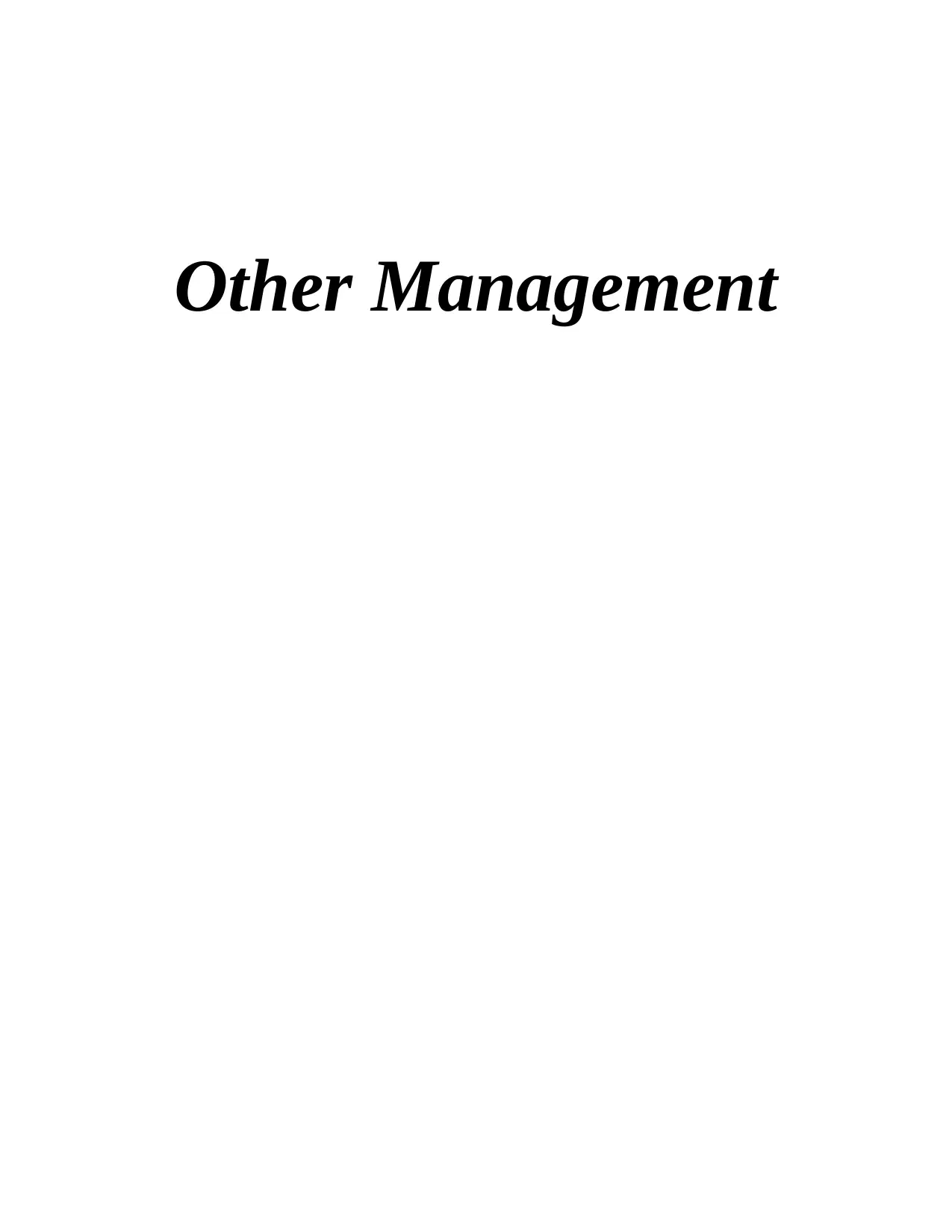
Other Management
Paraphrase This Document
Need a fresh take? Get an instant paraphrase of this document with our AI Paraphraser
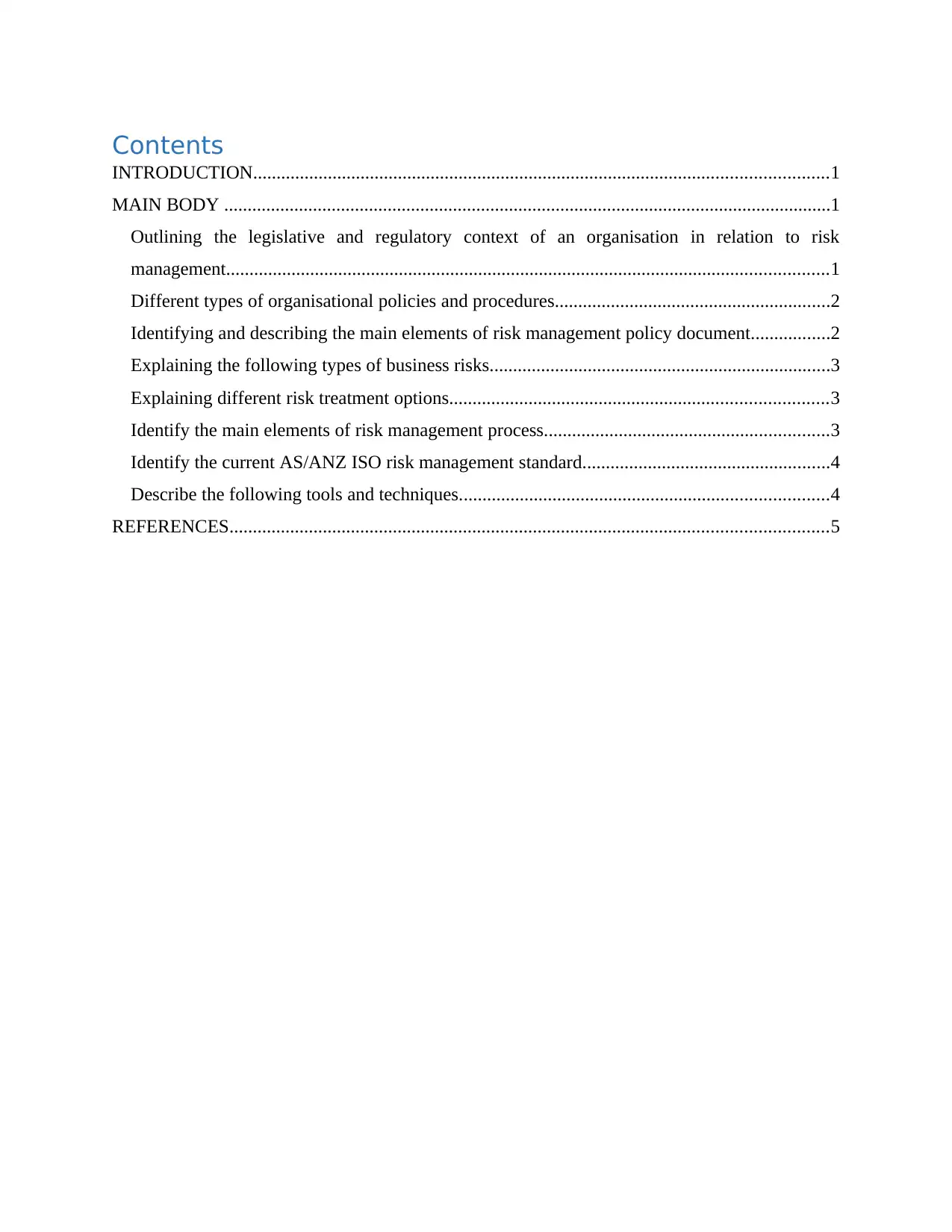
Contents
INTRODUCTION...........................................................................................................................1
MAIN BODY ..................................................................................................................................1
Outlining the legislative and regulatory context of an organisation in relation to risk
management.................................................................................................................................1
Different types of organisational policies and procedures...........................................................2
Identifying and describing the main elements of risk management policy document.................2
Explaining the following types of business risks.........................................................................3
Explaining different risk treatment options.................................................................................3
Identify the main elements of risk management process.............................................................3
Identify the current AS/ANZ ISO risk management standard.....................................................4
Describe the following tools and techniques...............................................................................4
REFERENCES................................................................................................................................5
INTRODUCTION...........................................................................................................................1
MAIN BODY ..................................................................................................................................1
Outlining the legislative and regulatory context of an organisation in relation to risk
management.................................................................................................................................1
Different types of organisational policies and procedures...........................................................2
Identifying and describing the main elements of risk management policy document.................2
Explaining the following types of business risks.........................................................................3
Explaining different risk treatment options.................................................................................3
Identify the main elements of risk management process.............................................................3
Identify the current AS/ANZ ISO risk management standard.....................................................4
Describe the following tools and techniques...............................................................................4
REFERENCES................................................................................................................................5

⊘ This is a preview!⊘
Do you want full access?
Subscribe today to unlock all pages.

Trusted by 1+ million students worldwide
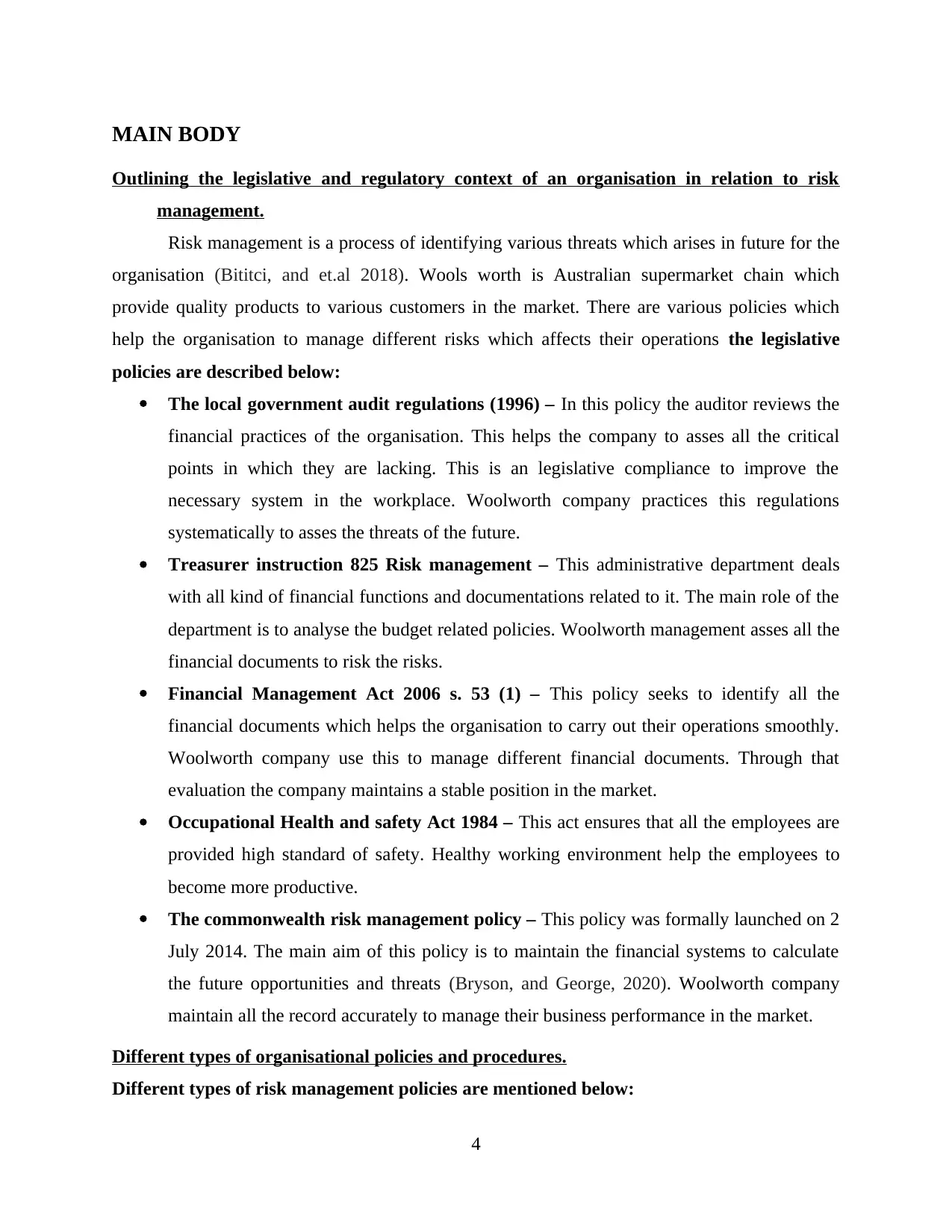
MAIN BODY
Outlining the legislative and regulatory context of an organisation in relation to risk
management.
Risk management is a process of identifying various threats which arises in future for the
organisation (Bititci, and et.al 2018). Wools worth is Australian supermarket chain which
provide quality products to various customers in the market. There are various policies which
help the organisation to manage different risks which affects their operations the legislative
policies are described below:
The local government audit regulations (1996) – In this policy the auditor reviews the
financial practices of the organisation. This helps the company to asses all the critical
points in which they are lacking. This is an legislative compliance to improve the
necessary system in the workplace. Woolworth company practices this regulations
systematically to asses the threats of the future.
Treasurer instruction 825 Risk management – This administrative department deals
with all kind of financial functions and documentations related to it. The main role of the
department is to analyse the budget related policies. Woolworth management asses all the
financial documents to risk the risks.
Financial Management Act 2006 s. 53 (1) – This policy seeks to identify all the
financial documents which helps the organisation to carry out their operations smoothly.
Woolworth company use this to manage different financial documents. Through that
evaluation the company maintains a stable position in the market.
Occupational Health and safety Act 1984 – This act ensures that all the employees are
provided high standard of safety. Healthy working environment help the employees to
become more productive.
The commonwealth risk management policy – This policy was formally launched on 2
July 2014. The main aim of this policy is to maintain the financial systems to calculate
the future opportunities and threats (Bryson, and George, 2020). Woolworth company
maintain all the record accurately to manage their business performance in the market.
Different types of organisational policies and procedures.
Different types of risk management policies are mentioned below:
4
Outlining the legislative and regulatory context of an organisation in relation to risk
management.
Risk management is a process of identifying various threats which arises in future for the
organisation (Bititci, and et.al 2018). Wools worth is Australian supermarket chain which
provide quality products to various customers in the market. There are various policies which
help the organisation to manage different risks which affects their operations the legislative
policies are described below:
The local government audit regulations (1996) – In this policy the auditor reviews the
financial practices of the organisation. This helps the company to asses all the critical
points in which they are lacking. This is an legislative compliance to improve the
necessary system in the workplace. Woolworth company practices this regulations
systematically to asses the threats of the future.
Treasurer instruction 825 Risk management – This administrative department deals
with all kind of financial functions and documentations related to it. The main role of the
department is to analyse the budget related policies. Woolworth management asses all the
financial documents to risk the risks.
Financial Management Act 2006 s. 53 (1) – This policy seeks to identify all the
financial documents which helps the organisation to carry out their operations smoothly.
Woolworth company use this to manage different financial documents. Through that
evaluation the company maintains a stable position in the market.
Occupational Health and safety Act 1984 – This act ensures that all the employees are
provided high standard of safety. Healthy working environment help the employees to
become more productive.
The commonwealth risk management policy – This policy was formally launched on 2
July 2014. The main aim of this policy is to maintain the financial systems to calculate
the future opportunities and threats (Bryson, and George, 2020). Woolworth company
maintain all the record accurately to manage their business performance in the market.
Different types of organisational policies and procedures.
Different types of risk management policies are mentioned below:
4
Paraphrase This Document
Need a fresh take? Get an instant paraphrase of this document with our AI Paraphraser
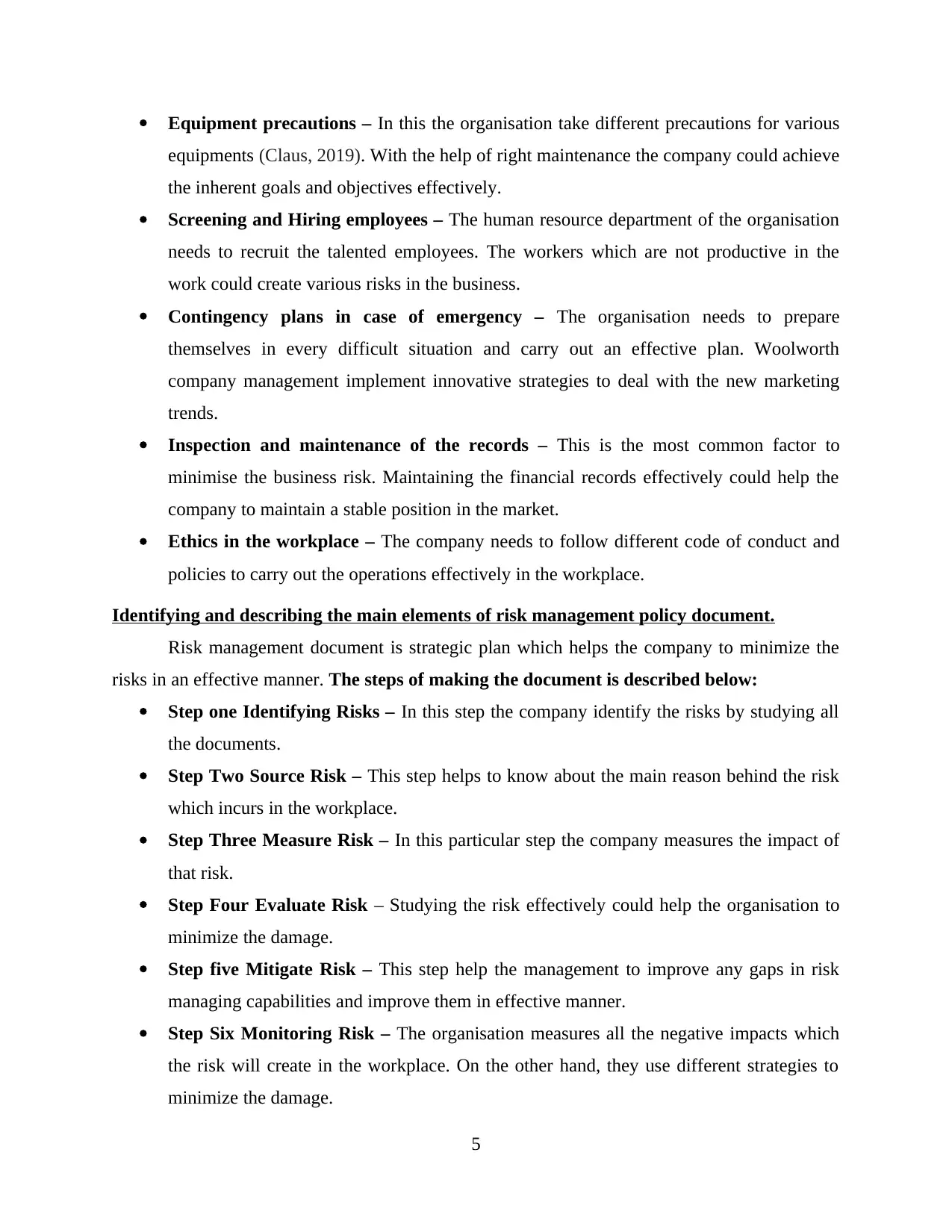
Equipment precautions – In this the organisation take different precautions for various
equipments (Claus, 2019). With the help of right maintenance the company could achieve
the inherent goals and objectives effectively.
Screening and Hiring employees – The human resource department of the organisation
needs to recruit the talented employees. The workers which are not productive in the
work could create various risks in the business.
Contingency plans in case of emergency – The organisation needs to prepare
themselves in every difficult situation and carry out an effective plan. Woolworth
company management implement innovative strategies to deal with the new marketing
trends.
Inspection and maintenance of the records – This is the most common factor to
minimise the business risk. Maintaining the financial records effectively could help the
company to maintain a stable position in the market.
Ethics in the workplace – The company needs to follow different code of conduct and
policies to carry out the operations effectively in the workplace.
Identifying and describing the main elements of risk management policy document.
Risk management document is strategic plan which helps the company to minimize the
risks in an effective manner. The steps of making the document is described below:
Step one Identifying Risks – In this step the company identify the risks by studying all
the documents.
Step Two Source Risk – This step helps to know about the main reason behind the risk
which incurs in the workplace.
Step Three Measure Risk – In this particular step the company measures the impact of
that risk.
Step Four Evaluate Risk – Studying the risk effectively could help the organisation to
minimize the damage.
Step five Mitigate Risk – This step help the management to improve any gaps in risk
managing capabilities and improve them in effective manner.
Step Six Monitoring Risk – The organisation measures all the negative impacts which
the risk will create in the workplace. On the other hand, they use different strategies to
minimize the damage.
5
equipments (Claus, 2019). With the help of right maintenance the company could achieve
the inherent goals and objectives effectively.
Screening and Hiring employees – The human resource department of the organisation
needs to recruit the talented employees. The workers which are not productive in the
work could create various risks in the business.
Contingency plans in case of emergency – The organisation needs to prepare
themselves in every difficult situation and carry out an effective plan. Woolworth
company management implement innovative strategies to deal with the new marketing
trends.
Inspection and maintenance of the records – This is the most common factor to
minimise the business risk. Maintaining the financial records effectively could help the
company to maintain a stable position in the market.
Ethics in the workplace – The company needs to follow different code of conduct and
policies to carry out the operations effectively in the workplace.
Identifying and describing the main elements of risk management policy document.
Risk management document is strategic plan which helps the company to minimize the
risks in an effective manner. The steps of making the document is described below:
Step one Identifying Risks – In this step the company identify the risks by studying all
the documents.
Step Two Source Risk – This step helps to know about the main reason behind the risk
which incurs in the workplace.
Step Three Measure Risk – In this particular step the company measures the impact of
that risk.
Step Four Evaluate Risk – Studying the risk effectively could help the organisation to
minimize the damage.
Step five Mitigate Risk – This step help the management to improve any gaps in risk
managing capabilities and improve them in effective manner.
Step Six Monitoring Risk – The organisation measures all the negative impacts which
the risk will create in the workplace. On the other hand, they use different strategies to
minimize the damage.
5
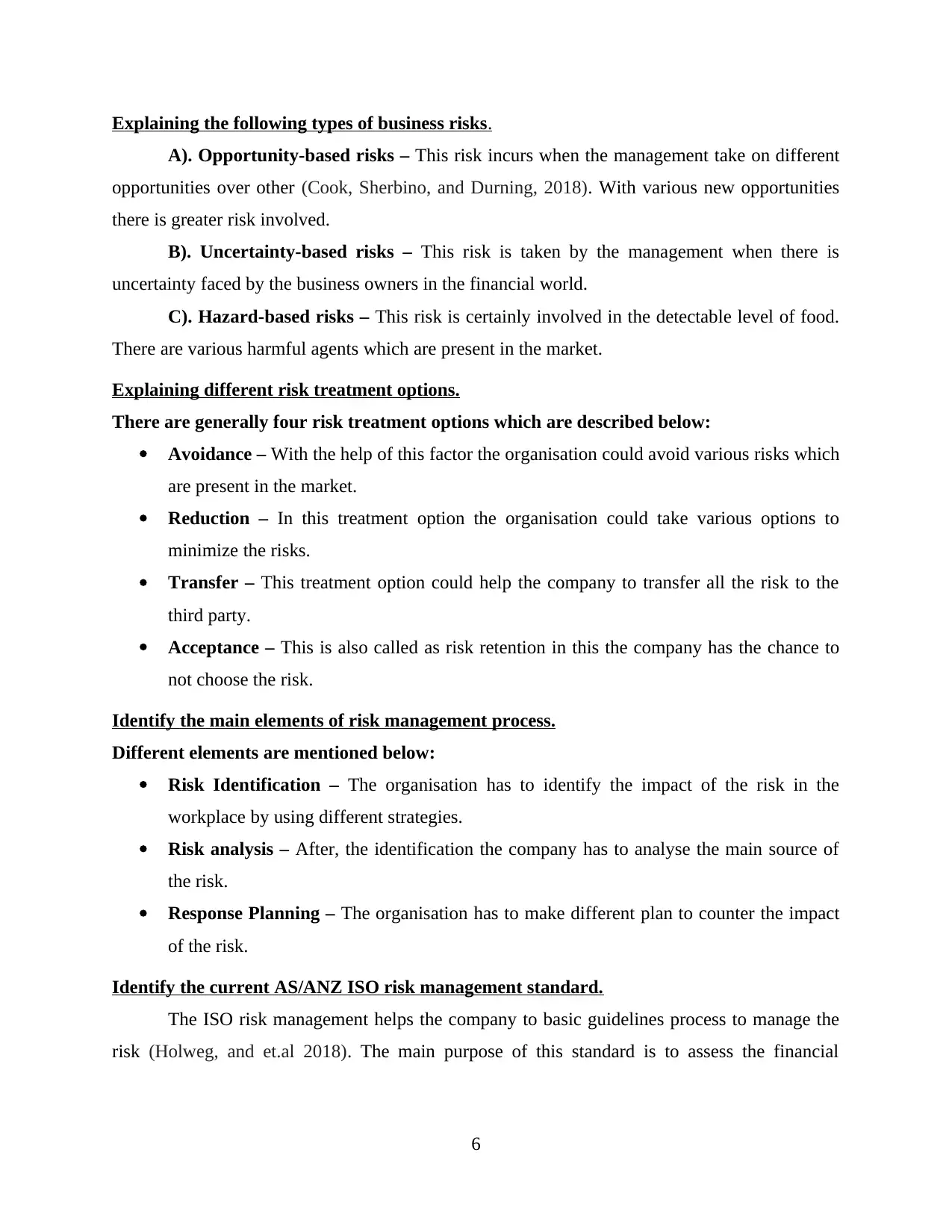
Explaining the following types of business risks.
A). Opportunity-based risks – This risk incurs when the management take on different
opportunities over other (Cook, Sherbino, and Durning, 2018). With various new opportunities
there is greater risk involved.
B). Uncertainty-based risks – This risk is taken by the management when there is
uncertainty faced by the business owners in the financial world.
C). Hazard-based risks – This risk is certainly involved in the detectable level of food.
There are various harmful agents which are present in the market.
Explaining different risk treatment options.
There are generally four risk treatment options which are described below:
Avoidance – With the help of this factor the organisation could avoid various risks which
are present in the market.
Reduction – In this treatment option the organisation could take various options to
minimize the risks.
Transfer – This treatment option could help the company to transfer all the risk to the
third party.
Acceptance – This is also called as risk retention in this the company has the chance to
not choose the risk.
Identify the main elements of risk management process.
Different elements are mentioned below:
Risk Identification – The organisation has to identify the impact of the risk in the
workplace by using different strategies.
Risk analysis – After, the identification the company has to analyse the main source of
the risk.
Response Planning – The organisation has to make different plan to counter the impact
of the risk.
Identify the current AS/ANZ ISO risk management standard.
The ISO risk management helps the company to basic guidelines process to manage the
risk (Holweg, and et.al 2018). The main purpose of this standard is to assess the financial
6
A). Opportunity-based risks – This risk incurs when the management take on different
opportunities over other (Cook, Sherbino, and Durning, 2018). With various new opportunities
there is greater risk involved.
B). Uncertainty-based risks – This risk is taken by the management when there is
uncertainty faced by the business owners in the financial world.
C). Hazard-based risks – This risk is certainly involved in the detectable level of food.
There are various harmful agents which are present in the market.
Explaining different risk treatment options.
There are generally four risk treatment options which are described below:
Avoidance – With the help of this factor the organisation could avoid various risks which
are present in the market.
Reduction – In this treatment option the organisation could take various options to
minimize the risks.
Transfer – This treatment option could help the company to transfer all the risk to the
third party.
Acceptance – This is also called as risk retention in this the company has the chance to
not choose the risk.
Identify the main elements of risk management process.
Different elements are mentioned below:
Risk Identification – The organisation has to identify the impact of the risk in the
workplace by using different strategies.
Risk analysis – After, the identification the company has to analyse the main source of
the risk.
Response Planning – The organisation has to make different plan to counter the impact
of the risk.
Identify the current AS/ANZ ISO risk management standard.
The ISO risk management helps the company to basic guidelines process to manage the
risk (Holweg, and et.al 2018). The main purpose of this standard is to assess the financial
6
⊘ This is a preview!⊘
Do you want full access?
Subscribe today to unlock all pages.

Trusted by 1+ million students worldwide
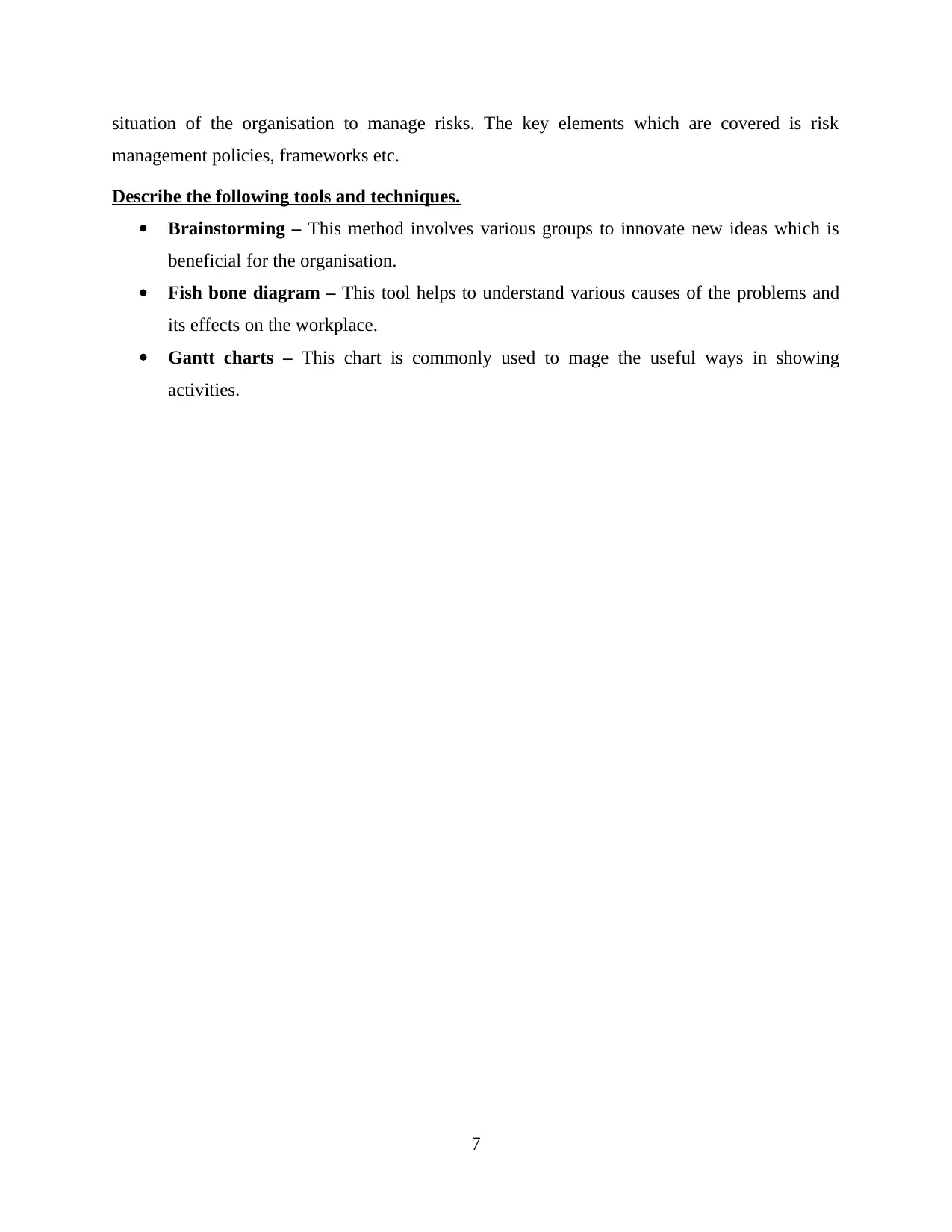
situation of the organisation to manage risks. The key elements which are covered is risk
management policies, frameworks etc.
Describe the following tools and techniques.
Brainstorming – This method involves various groups to innovate new ideas which is
beneficial for the organisation.
Fish bone diagram – This tool helps to understand various causes of the problems and
its effects on the workplace.
Gantt charts – This chart is commonly used to mage the useful ways in showing
activities.
7
management policies, frameworks etc.
Describe the following tools and techniques.
Brainstorming – This method involves various groups to innovate new ideas which is
beneficial for the organisation.
Fish bone diagram – This tool helps to understand various causes of the problems and
its effects on the workplace.
Gantt charts – This chart is commonly used to mage the useful ways in showing
activities.
7
Paraphrase This Document
Need a fresh take? Get an instant paraphrase of this document with our AI Paraphraser
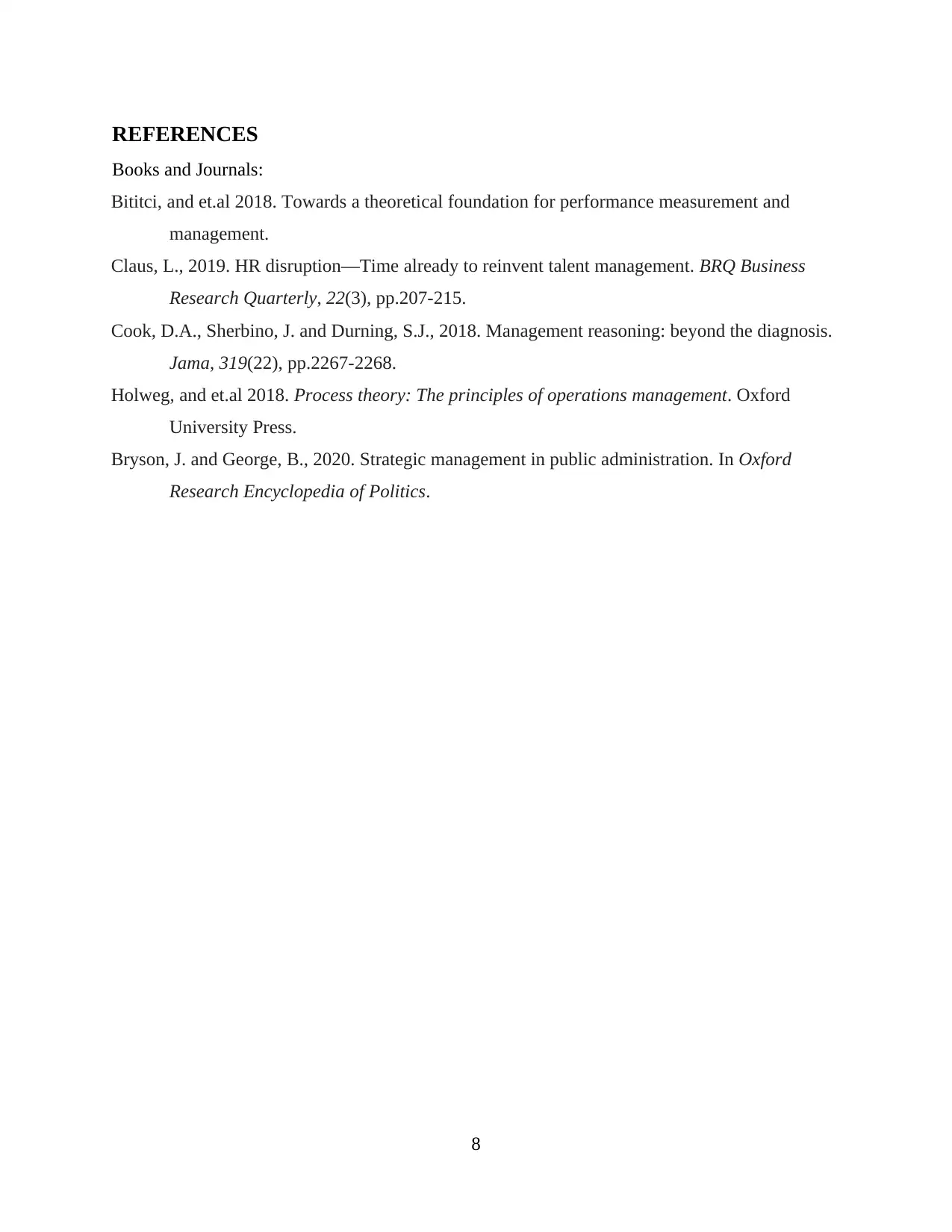
REFERENCES
Books and Journals:
Bititci, and et.al 2018. Towards a theoretical foundation for performance measurement and
management.
Claus, L., 2019. HR disruption—Time already to reinvent talent management. BRQ Business
Research Quarterly, 22(3), pp.207-215.
Cook, D.A., Sherbino, J. and Durning, S.J., 2018. Management reasoning: beyond the diagnosis.
Jama, 319(22), pp.2267-2268.
Holweg, and et.al 2018. Process theory: The principles of operations management. Oxford
University Press.
Bryson, J. and George, B., 2020. Strategic management in public administration. In Oxford
Research Encyclopedia of Politics.
8
Books and Journals:
Bititci, and et.al 2018. Towards a theoretical foundation for performance measurement and
management.
Claus, L., 2019. HR disruption—Time already to reinvent talent management. BRQ Business
Research Quarterly, 22(3), pp.207-215.
Cook, D.A., Sherbino, J. and Durning, S.J., 2018. Management reasoning: beyond the diagnosis.
Jama, 319(22), pp.2267-2268.
Holweg, and et.al 2018. Process theory: The principles of operations management. Oxford
University Press.
Bryson, J. and George, B., 2020. Strategic management in public administration. In Oxford
Research Encyclopedia of Politics.
8
1 out of 8
Related Documents
Your All-in-One AI-Powered Toolkit for Academic Success.
+13062052269
info@desklib.com
Available 24*7 on WhatsApp / Email
![[object Object]](/_next/static/media/star-bottom.7253800d.svg)
Unlock your academic potential
Copyright © 2020–2025 A2Z Services. All Rights Reserved. Developed and managed by ZUCOL.





